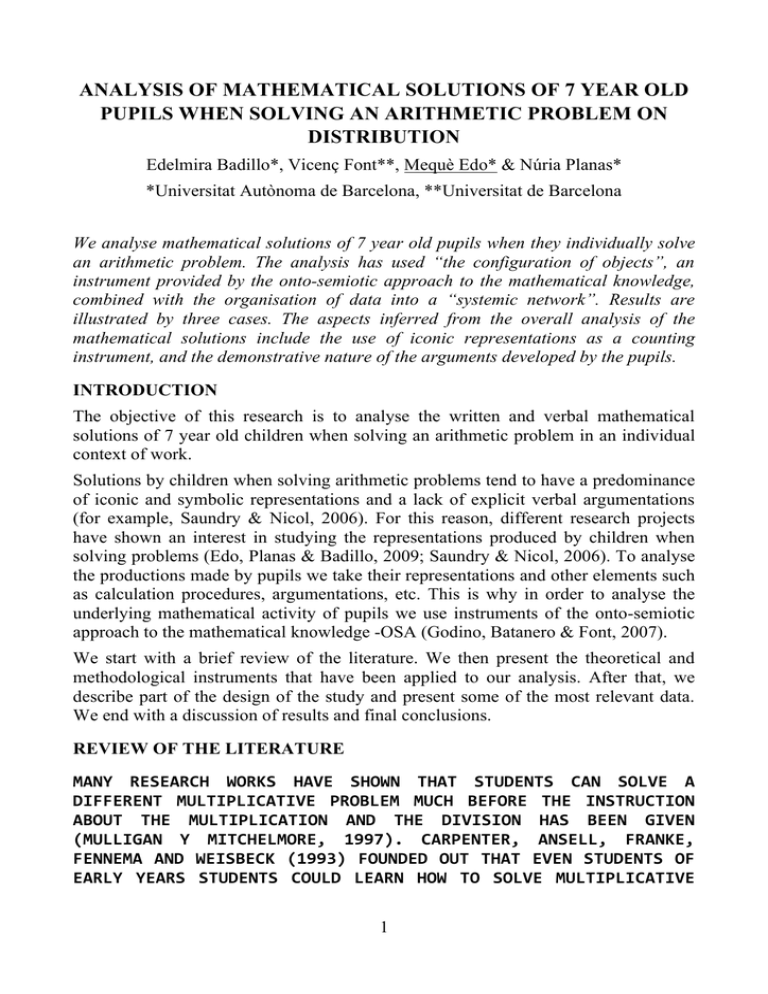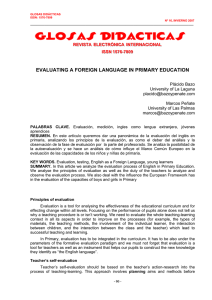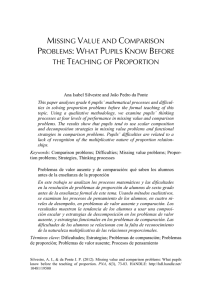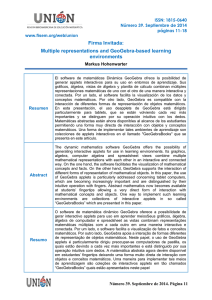analysis of mathematical solutions of 7 year old pupils
Anuncio

ANALYSIS OF MATHEMATICAL SOLUTIONS OF 7 YEAR OLD
PUPILS WHEN SOLVING AN ARITHMETIC PROBLEM ON
DISTRIBUTION
Edelmira Badillo*, Vicenç Font**, Mequè Edo* & Núria Planas*
*Universitat Autònoma de Barcelona, **Universitat de Barcelona
We analyse mathematical solutions of 7 year old pupils when they individually solve
an arithmetic problem. The analysis has used “the configuration of objects”, an
instrument provided by the onto-semiotic approach to the mathematical knowledge,
combined with the organisation of data into a “systemic network”. Results are
illustrated by three cases. The aspects inferred from the overall analysis of the
mathematical solutions include the use of iconic representations as a counting
instrument, and the demonstrative nature of the arguments developed by the pupils.
INTRODUCTION
The objective of this research is to analyse the written and verbal mathematical
solutions of 7 year old children when solving an arithmetic problem in an individual
context of work.
Solutions by children when solving arithmetic problems tend to have a predominance
of iconic and symbolic representations and a lack of explicit verbal argumentations
(for example, Saundry & Nicol, 2006). For this reason, different research projects
have shown an interest in studying the representations produced by children when
solving problems (Edo, Planas & Badillo, 2009; Saundry & Nicol, 2006). To analyse
the productions made by pupils we take their representations and other elements such
as calculation procedures, argumentations, etc. This is why in order to analyse the
underlying mathematical activity of pupils we use instruments of the onto-semiotic
approach to the mathematical knowledge -OSA (Godino, Batanero & Font, 2007).
We start with a brief review of the literature. We then present the theoretical and
methodological instruments that have been applied to our analysis. After that, we
describe part of the design of the study and present some of the most relevant data.
We end with a discussion of results and final conclusions.
REVIEW OF THE LITERATURE
MANY RESEARCH WORKS HAVE SHOWN THAT STUDENTS CAN SOLVE A DIFFERENT MULTIPLICATIVE PROBLEM MUCH BEFORE THE INSTRUCTION ABOUT THE MULTIPLICATION AND THE DIVISION HAS BEEN GIVEN (MULLIGAN Y MITCHELMORE, 1997). CARPENTER, ANSELL, FRANKE, FENNEMA AND WEISBECK (1993) FOUNDED OUT THAT EVEN STUDENTS OF EARLY YEARS STUDENTS COULD LEARN HOW TO SOLVE MULTIPLICATIVE 1
PROBLEMS. SUCH STUDIES HAVE ALSO BEEN CARRIED OUT WITH STUDENTS WITH SPECIAL EDUCATIVE NEEDS (NUNES, BRYANT, BURMAN, BELL, EVANS & HALLETT, 2009)
Much research has been done on primary age arithmetic problems on distribution in
which the task is to share a number of elements that are to be shared out one by one
among a variable number of participants; for example, to share out a number of
cookies among different children on the basis of questions with multiple solutions
(Davis y Hunting, 1990). Research has also been done on problems that work on the
idea of the division of units and distribution. Charles and Nason (2000), in a study of
the development of the concept of fractions among 8 year old children, proposed a
type of problem in which the unit(s) is/are divided into parts.
We examine the particular case in which the context requires the elements to be
separated into groups, which involves a distribution in which not everything is a unit
(or several units) that has to be divided into parts, but in which everything has to be
separated into discrete sets, that can(not) have a different cardinal.
THEORETICAL AND METHODOLOGICAL FOUNDATION
Some studies involving the OSA (Malaspina & Font, 2010), in which mathematical
solutions have been analysed, first consider the mathematical practices and then the
mathematical objects and processes that are activated in them. In this study we adapt
such approach with the pupils’ practices being the reading of the text of the
arithmetic problem and the production of a written answer. Due to space limitations,
we will only analyze the mathematical objects that are activated by said practice.
If we consider the mathematical objects activated in undertaking a practice that
enables the resolution of a problem situation (e.g. tackling and solving an arithmetic
problem), we observe the use of verbal, iconic, symbolic and other representations.
These representations are the ostensive part of a series of concepts/definitions,
propositions and procedures that intervene in the production of arguments to decide
whether the practice is satisfactory. So, when a pupil performs and evaluates a
mathematical practice s/he activates a conglomerate formed by problem situations,
representations, concepts, propositions, procedures and arguments, which are
articulated in the configuration of Figure 1 (Font & Godino, 2006, p. 69).
To move from the individual analysis on pupils’ mathematical solutions to a more
general analysis on the whole group, we used a systemic network. This is a classical
instrument from the organisation and interpretation of qualitative data proposed by
Bliss, Monk and Ogborn (1983).
DESIGN OF THE STUDY
The participant sample was made up of 21 primary school pupils (7 years of age) at a
school in Barcelona, Spain. The mathematical task presented to the pupils, which was
to be solved individually and in writing, was: 1) an arithmetic problem involving
2
distribution in which everything had to be separated into discrete sets of various
elements, which could (not) have a different cardinal; 2) an open-ended situation; and
3) a feasibly resolvable task using the pupils’ prior knowledge. The problem was: “If
you have 18 wheels, how many toys with wheels can you have?”
Figure 1. Configuration of objects
The problem was read aloud and the pupils were expected to solve it with paper and
pencil during a one-hour class. When they finished the task, they were individually
asked, “what did you do?” Their answers were recorded in audio and transcribed.
DATA ANALYSIS
Two types of analysis were performed, an analysis of each of the cases and then a
global one of all of the mathematical solutions. For the former, an analysis (Figure 1)
was made of each pupil’s solutions. Table 1 illustrates part of an example.
Following the categories suggested by Malaspina and Font (2010), the data was
analysed as indicated in Table 2. Each pupil’s mathematical practice was analysed
individually, paying attention to 1) representations, 2) concepts, 3) properties, 4)
procedures, and 5) arguments. We present the analysis of one of the mathematical
practices by one of the pupils, Pupil 15.
Figure 2 shows the systemic network obtained from the overall analysis. It is
organised into categories and aspects (using the terminology by Bliss, Monk and
Ogborn, 1983). We use braces ({) to represent inclusive aspects and lines to group
exclusive categories (|).
The analysis of the mathematical practices leads to two main categories. First we
have pupils that put the emphasis on the cardinal of the set. Here there are three
subcategories: 1) those which give a single answer (e.g. Pupil 10 says, “if I had 18
wheels I’d have 6 toys with wheels”); 2) those whose answers suggest more than one
answer (e.g. Pupil 15 writes, “I could have four toys with wheels”); and 3) those who
give more than one answer (the only case is Pupil 18 who gives four different
answers “…you could have 9 motorbikes, you could have 6 tricycles…”). Second we
have pupils who point to the set and only refer to it by extension (e.g. Pupil 12 says,
3
“I have made a car, a bike, a car, a scooter and another scooter”) or give the cardinal
for the subsets (e.g. Pupil 6 says, “four cars and a bicycle make 18 wheels”).
Written production
Verbal production
I have drawn a car that has four wheels, a
motorbike that has two, another motorbike
that has two and a train that has ten wheels.
And here I have explained what I have drawn
and how many wheels they all have. And
here I have added them up and this is the
answer.
Table 1. Data from Pupil 15
For each of the five subcategories above, we organised the data on the basis of the
mathematical objects following the configuration of objects in Figure 1. We
considered each object as an aspect in the systemic network. On this occasion, we
have grouped the procedures and properties as a single aspect and we have left the
argument aspect for another occasion. Given the richness of the responses, for each
aspect we have introduced meanings that have been used as categories; we do not go
into the details of all of them. We now illustrate three significant cases.
The case of Pupil 15
Pupil 15 solves the problem well by giving the cardinal of one of the possible sets
and concluding, “I could have 4 toys with wheels”. We consider that she is
suggesting there is more than one answer, as she uses the verb tense “could”. First,
we examine the richness of her representations. She starts with an iconic
representation of the toys in perspective (Table 1) and then translates this into a
symbolic numerical representation (4+2+2+6+4=18) and a verbal one (one car, two
motorbikes and one train have 18 wheels).
In relation to concepts, this pupil breaks down the set of wheels (18) into parts or
subsets (she draws a 4-wheeled car, two 2-wheeled motorbikes and a 10-wheeled
train). She is then able to treat each of the subsets as an element (a toy) in a new set
(the set of toys). Finally, she implicitly distinguishes between a set and the cardinal of
a set, because in her answer she refers to the cardinal of the set of toys.
4
Figure 2. Systemic network from the overall analysis of the pupils’ answers2
5
This pupil applies the property that “a number can be broken down into the sum of
smaller numbers”, in order to break down 18 (into three different addends) and 10
(into two different addends): 4+2+2+2+6+4. We consider this pupil to be aware of
the application of this property because she writes (6+4) and draws a two-carriage
train with 6 and 4 wheels, though in her verbal answer she refers to a train with 10
wheels.
Mathematical Object
Problem situation
Mathematical practice
If you have 18 wheels, how many toys with wheels could you have?
• Iconic with perspective
Representation
• Symbolic
Concepts
Properties
Procedures
Arguments
- Verbal (one, four, two, ten)
- Numbers (4, 2, 6, 18)
- Signs (+, =)
• Addition (Previous)
• Implicit terms of the addition (addends and results)
• Number (Previous)
• Subtraction (implicit)
• Set
• Elements of a set
• A number can be broken down as the sum of smaller numbers (this is applied
to 10 and to 18)
• Combination of numbers to obtain 18
• Add and subtract (mentally)
• Determination of a set by extension
• Explicit thesis: I could have 4 toys with wheels (to make 18)
• Graphic argument: draws the 4 toys
• Verbal argument: describes the elements of the set (a 4-wheeled car, two 2wheeled motorbikes and a 10-wheeled train)
• Numerical-written argument: 4 + 2 + 2 + 6 + 4 = 18
Table 2. Configuration of objects in Pupil 15’s answer
In relation to procedures, she uses the previous property to break down number 18.
She seems to take a first number (she draws a 4-wheeled car), then adds another
number (she draws a two-wheeled motorbike), and as the result is less than 18, she
adds another addend (a two-wheeled motorbike); given that the result is still less than
18, she adds another addend (a ten-wheeled train). She iconically determines the set
by extension.
Finally, the explicit thesis of her demonstrative argument (she could have 4 toys with
wheels) is justified by the ostensive presentation of the set (iconic representation and
verbal description) and by the numerical-written verification (4+2+2+2+6+4=18), of
which she is aware because she says, “…and here I have added them up…”.
6
The case of Pupil 19
Pupil 19 solves the problem implicitly in that he draws 6 tricycles (Figure 3). We
consider this to be implicit because the pupil expresses the cardinal of the set of
wheels (18), which leads to start the solving process using symbolic representations.
This pupil starts his answer with a symbolic-numerical representation based on the
sum (3+3+3+3+3+3=18) and translates this to another symbolic expression based on
multiplication (3x6=18, see Figures 2 and 3). Later, he switches to an iconic
representation without perspective.
Figure 3. Representations used by Pupil 19
In relation to concepts, this pupil comes to the concept of multiplication and seems to
be clear of its concept as a repeating addition. We consider this because he uses a
mathematical property: “18 can be broken down as the repeated addition of number
three”. In relation to procedures, he uses the previous property to break down number
18. He likely takes a first number, 3, then adds another 3, and given that result is still
less than 18, he adds another addend (3), and so on successively until he reaches
number 18. He iconically determines the set by extension.
Finally, the explicit thesis of his argument (6 tricycles make 18 wheels) is justified by
the ostensive presentation of the set (iconic representation). He gives a verbal
description of the procedure he used to get to number 18 (I did three plus three…).
The case of Pupil 20
Pupil 20 solves the problem implicitly, as he draws two cars, a truck and a scooter
(Figure 4). He also gives the cardinal of the subsets as a verbal response (2 cars, 1
scooter and 1 truck). We find his type of representation significant, and we have
named it in the systemic (Figure 2), iconic and symbolic (Figure 4) networks. The
drawings are not in perspective but the pupil represents the total number wheels on
each toy using numerical symbols (
). The only conversion he makes is to switch
from an iconic and symbolic representation of the set of toys to a verbal and written
description of the cardinal of the subsets.
In relation to concepts, he breaks down the set of wheels (18) into parts or subsets (he
draws 2 cars with 4 wheels, 1 scooter with 2 wheels and a truck with 8 wheels).
7
After, he gives the cardinal of the subsets (2 cars, 1 scooter and 1 truck). Meanwhile,
he implies the mathematical property: “18 can be broken down into the sum of
smaller numbers” in order to break down 18 (into four addends, three of which are
different): four, four, two and eight.
In relation to concepts, this pupil uses the previous property to break down the
eighteen. We consider that he takes a first number (he draws a four-wheeled car),
adds another number 3, then adds another (he draws another four-wheeled car), and
as the result is less than 18 he adds another addend (and eight-wheeled truck). He
iconically determines the set by extension. The explicit thesis of his demonstrative
argument (2 cars, 1 scooter and 1 truck) is justified by the ostensive presentation of
the set (iconic representation and verbal-written description).
Figure 4. Representations used by Pupil 20.
CONCLUSION
All of the pupils make an iconic representation of the set of toys. It could be said that
this is because of the need at this age to work using contextualised scenarios.
However, there is also the need to use drawing as a counting instrument, as has been
shown by Saundry and Nicol (2006). In our study, this use of iconic representations
as a counting instrument is made clear in the representation that we have called iconic
and symbolic (Figure 4). This is a type of representation (used by Pupils 8 and 20),
that can be considered an intermediate step between flat representations (used by
Pupils 6, 7, 9, 11, 13, 14, 18, 19) and representations in perspective (used by Pupils 1,
2, 3, 4, 5, 8, 10, 12, 15, 16 17, 21).
There are three pupils (3, 17, 19) who separate the set of 18 wheels into discrete sets
with an equal cardinal and start solving the problem using written symbolicnumerical representations (they break 18 down into equal addends). In all three cases,
they translate this representation into another written symbolic expression in which
they use the concept of multiplication (Figure 5), to end with a conversion to an
iconic representation of the set of toys. In cases 3 and 17 this is in perspective and in
case 19 without perspective (Figure 3).
Figure 5. Breakdown of equal addends into multiplication
8
Pupil 18 uses multiplication in his four different answers (which are given verbally
and iconically). But he does not use written symbolic-numerical representations, so
we suppose he reached his answer by making mental calculations. From his verbal
responses, we infer that he makes an implicit use of the commutative property (“you
can have 6 tricycles with three wheels or you can have 3 limousines with 6 wheels
and you also get 18”) and that, unlike the three previous pupils, he does not need to
explicitly break 18 down into equal addends to break 18 down into the product of two
factors. He does not need to add first in order to get to multiplication.
All of the pupils implicitly or explicitly use the property of breaking 18 down into
addends (we include the extreme case of Pupil 18 who breaks 18 down using 4x4+2).
When the addends are equal, this facilitates the use of the concept of multiplication,
and on the other hand, facilitates the process of giving the cardinal for a set of toys of
a certain type (e.g. Pupil 17’s answer, “6 tricycles”), which implies that the term
“toy”, which is more abstract, is not used. However, the two pupils that explicitly use
that term in their answers (e.g. Pupil 15, “I could have 4 toys with wheels”), break
number 18 down into different addends.
In this last case we have the close relationship between properties and concepts. The
use of a certain mathematical property (a type of breakdown of number 18)
conditions the use of certain mathematical concepts (addition or multiplication).
Meanwhile, the use of multiplication -a concept that is considered, in curricular
terms, to be more difficult than addition- involves, in this case, less abstraction in
solving the problem.
We observe two fundamental procedures. One is related with the application of the
mathematical property/ies that guarantee the breakdown of number 18 into addends.
The pupils mentally apply addition and subtraction, and even multiplication, to reach
that breakdown. The other is the determination by extension of the set (via an iconic
representation). This latter method, used by all pupils, is the one that enables them to
defend, explicitly or implicitly, their answer. These are demonstrative arguments that
consist of the ostensive presentation of the set (the drawings of the toys).
We consider the theoretical categories provided by the OSA to facilitate an in-depth
analysis of the pupils’ solutions and to reveal the complexity of objects (concepts,
representations, properties, etc.) that are activated when solving arithmetic problems.
The systemic network has also been a powerful instrument of organization that has
led to construct a taxonomy of the pupils’ responses when they solve a problem in
which the whole has to be separated into discrete sets of various elements, which can
also have (or not) a different cardinal.
ACKNOWLEDGEMENTS
The research is part of Projects EDU2009-07113/EDUC and EDU200908120/EDUC, from the Spanish Ministry of Science and Innovation.
9
NOTES
1. *The represented drawings are in perspective. ** Without in perspective.
2. The pupils that draw an iconic representation and give a verbal description of the set of toys
(almost all), are part of the aspect “makes a translation/conversion”. When the pupil also makes
another type of translation/conversion, s/he is part of “makes several translations/conversions”.
REFERENCES
Bliss, J., Monk, M., & Ogborn, J. (1983). Qualitative data analysis for educational
research. London, UK: Croom Helm.
Carpenter, T., Ansell, E., Franke, M., Fennema, E. & Weisbeck, L. (1993). Models of
problem solving: a study of kindergarten children’s problem-solving processes.
Journal for Research in Mathematics Education, 24(5), 428-441.
Charles, K., & Nason, R. (2000). Young children’s partitioning strategies.
Educational Studies in Mathematics Education, 43(2), 191-221.
Davis, G. & Hunting, R. P. (1990). Spontaneous partitioning: Pre-schoolers ad
discrete itms. Educational Studies in Mathematics, 21(4), 367-374.
Edo, M., Planas, N., & Badillo, E. (2009). Mathematical learning in a context of play.
European Early Childhood Education Research Journal, 17(3), 325-341.
Font, V., & Godino, J. D. (2006). La noción de configuración epistémica como
herramienta de análisis de textos matemáticos: su uso en la formación de
profesores. Educaçao Matemática e Pesquisa, 8(1), 67-98.
Godino, J. D., Batanero, C. & Font, V. (2007). The onto-semiotic approach to
research in mathematics education, ZDM-The International Journal on
Mathematics Education, 39(1-2), 127-135.
Malaspina, U., & Font, V. (2010). The role of intuition in the solving of optimization
problems. Educational Studies in Mathematics, 75(1), 107-130.
Mulligan, J. & Mitchelmore, M. C. (1997). Young children’s intuitive models of
multiplication and division. Journal for Research in Mathematics Education,
28(3), 309-330.
Nunes, T., Bryant, P., Burman, D., Bell, D., Evans, D. & Hallett, D. (2009). Deaf
children's
informal
knowledge
of
multiplicative
reasoning.
Journal of deaf studies and deaf education, 14(2), 260-77.
Saundry, C., & Nicol, C. (2006). Drawing as problem-solving: Young children’s
mathematical reasoning through pictures. In J. Novotná, H. Moraová, M. Krátká &
N. Stehlíková (Eds.), Proceedings of the 30th Conference of the International
Group for the Psychology of Mathematics Education (v. 5, pp. 57-63). Prague,
Czech Republic: PME.
10






